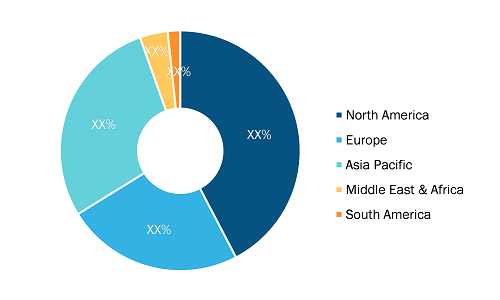The small satellite market was valued at US$ 3,131.09 million in 2022; registering at a CAGR of 24.7% from 2022 to 2028, according to a new research study conducted by The Insight Partners.
Growing IoT and Communication Applications to Provide Growth Opportunities for Small Satellite Market During 2022–2028
The small satellite market is one of the fastest-growing divisions in the global satellite industry. The small satellite market growth is attributed to the rising demand for the development of compact satellite systems. Small satellites are used in different applications that were traditionally performed by large satellites due to lower development and launching costs. As a result, the overall payload of the satellite is reduced, which results in high fuel efficiency of launch rockets.
Small Satellite Market — by Region, 2022

Small Satellite Market Growth Report | Size & Forecast 2031
Download Free SampleSmall Satellite Market Size and Forecast (2021 - 2031), Global and Regional Share, Trend, and Growth Opportunity Analysis Report Coverage: By Type [Nanosatellite (1 to 10 Kg), Microsatellite (10 to 150 Kg)]; Payload [Automatic Identification System (AIS), Transmitter, Imaging Devices, Others]; Application (Earth Observation, Communication & Navigation, Scientific Research); Vertical (Government, Military, Commercial); and Geography
Source: The Insight Partners Analysis
The nanosatellite/microsatellite segments in the small satellite sector have witnessed significant growth in terms of deployment and manufacturing. For instance, according to Spaceworks, the number of nanosatellites/microsatellites in the space grew from ~20 in 2011 to ~200 in 2019. Similarly, ~326 nanosatellites were launched in 2021. Further, the launch of ~250 nanosatellites has been scheduled for 2022, which is generating the demand for the development of small satellites.
The growing need for the development of small satellites that have a payload of below 150 kg is attributed to the rise in the demand for small satellite constellations. Many companies such as SpaceX and OneWeb have launched satellite constellation projects, wherein the companies have also launched some small satellites into the operational satellite orbit. Moreover, several companies such as Airbus are engaged in the production of Arrow satellites in the OneWeb constellation that has a payload of below 150 kg. Similarly, SpaceX has launched the StarLink constellation initiative of small satellites, wherein a group of satellites are operating in the space to provide better internet access to 40 different countries across the world.
The demand for different types of nanosatellites, microsatellites, and picosatellites for various scheduled space missions is one of the major factors generating higher demand from the buyers of small satellites. The presence of large number of buyers across different regions with greater number of vendors presence across North America and Europe is leading to lower bargaining power of customers from other regions such as Asia Pacific, the Middle East & Africa, and South America.
The presence of market vendors such as Swarm Technologies, Thales SA, Airbus SAS, L3Harris Technologies Inc, and Surrey Satellite Technologies Ltd that have larger market share in terms of small satellite manufacturing is one of the major factors possessing higher competitive rivalry in the small satellite market. Moreover, major vendors are focusing on acquiring emerging players that have a very limited small satellite market. This is also leading to market consolidation among the major vendors.
Further, the growing number of small satellite launch projects is another major factor supporting the development and deployment of nanosatellites and microsatellites across multiple regions, thereby catalyzing the small satellite market growth. For instance, in 2021, SpaceX accounted for ~71% of the total number of small satellite launches. The company is focusing on the development of small satellites and providing other related services to its customers to remain competitive in the market. Further, several other players operating in the small satellite market are majorly focusing on the development of small satellites for military applications. Many defense contractors have been awarding contracts to the satellite manufacturers for developing nanosatellites and microsatellites for military applications in different countries across the world. For instance, in June 2020, GomSpace won a contract from the Norwegian Defence Research Establishment (FFI) for the development of nanosatellites to enhance Norway’s military tactical communications on the UHF band from a polar Low Earth Orbit (LEO). Such development projects are supporting the manufacturing of small satellites for the military segment.
The small satellite market size is segmented into type, payload, application, and vertical. By type, the small satellite market is bifurcated into nanosatellite (1 to 10 kg) and microsatellite (10 to 150 kg). In terms of payload, the small satellite market is categorized into automatic identification system (AIS), transmitter, imaging devices, and others. From application point of reference, the small satellite market is further segmented into earth observation, communication and navigation, scientific research. Based on vertical, the small satellite market is segmented into government, military, and commercial.
Swarm Technologies, Thales SA, Airbus SAS, L3Harris Technologies Inc, and Sierra Nevada Corporation are a few key small satellite market players profiled during the study. Several other major companies were studied and analyzed during this research study to get a holistic view of the small satellite market size and its ecosystem. The small satellite market report provides detailed small satellite market insights, which helps the small satellite market players strategize their growth.
Contact Us Phone: +1-646-491-9876Email Id: sales@theinsightpartners.com